Table of Contents
Dive into the enigmatic world of Amanita Muscaria, a mushroom shrouded in myth, mystery, and a wide array of effects on the human mind and body. This comprehensive exploration will unveil its historical uses, intriguing effects, and the modern perspective on this iconic fungus.
The Amanita muscaria mushroom, famous for its red and white appearance, is known for being poisonous and causing psychedelic effects. It has been part of many cultural traditions and scientific studies because of its unique properties. While it looks interesting, it’s important to be careful with it since it can alter your mind. People have used it in ancient rituals and modern research to explore its effects on consciousness and its role in history. Understanding this mushroom involves looking at both its benefits and dangers.
Key Takeaways
- Amanita muscaria, with its iconic red and white-spotted cap description, holds a rich historical significance as psychedelics and has been intertwined with various cultural traditions and mythologies, underscoring the importance of understanding its roots, symbolic meanings, and trip experiences.
- Proper identification and description of Amanita muscaria, a name crucial due to its distinct psychoactive capabilities and potential toxicity as psychedelics; familiarizing oneself with its taxonomy can prevent accidental ingestion of harmful look-alikes.
- The psychoactive effects of Amanita muscaria have led to its traditional use in religious and shamanic rituals; modern interest often revolves around its potential for psychological experimentation, highlighting the need for informed and respectful engagement with such substances.
- Despite its toxicity, Amanita muscaria, also known by the name fly agaric, presents potential benefits and medical applications in gummies, particularly in the realm of neuropharmacology, suggesting a need for further research into its compounds and their effects.
- The risks associated with Amanita muscaria, including possible side effects like nausea and hallucinations, emphasize the importance of practicing caution and seeking comprehensive safety guidelines before considering its use in gummies by its name.
- Understanding the practical guidance related to the responsible use, legal status, and ethical considerations of Amanita muscaria, including its incorporation into gummies, can empower individuals to make informed decisions, fostering a safer way to explore of its properties and cultural significance.
Historical Significance
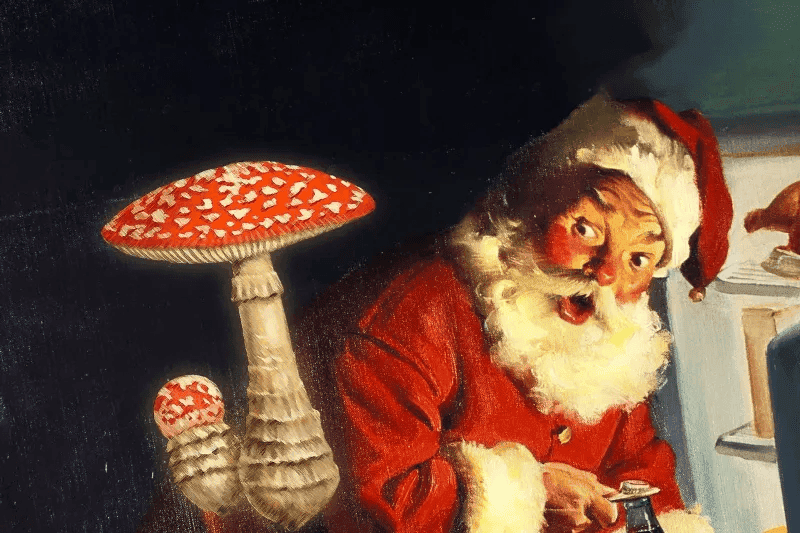
Cultural Impact
Amanita muscaria mushrooms have a deep cultural significance across the globe. These mushrooms are not just plants; they are icons woven into the fabric of many societies’ folklore and traditions.
In fairy tales, these red-capped mushrooms serve as magical elements that can lead characters to new realms or offer them special powers. They are often seen in illustrations, lending a mystical air to storybook forests.
Some cultures view Amanita muscaria as symbols of good luck and fortune. This belief has led people to incorporate mushroom motifs into various art forms, from paintings to sculptures.
The influence of these mushrooms extends into modern media and pop culture references too. Their distinctive appearance makes them easily recognizable symbols associated with magic and mysticism.
Siberian Shamanism
Within Siberian shamanic practices, Amanita muscaria holds a pivotal role. Shamans consume these mushrooms for spiritual rituals aiming at achieving visions or connecting with the spirit world.
This practice is believed to act as a bridge between the physical realm and the spirit world, facilitating communication with spirits or ancestors for guidance or healing purposes.
Shamans ingest Amanita muscaria during healing ceremonies believing it provides strength and endurance necessary for their spiritual journeying.
Such use underscores its integral position in shamanic tradition and lore, highlighting its within indigenous cultures’ spiritual practices.
Viking Culture
The fierce warriors known as Berserkers might have used Amanita muscaria before entering battle according to some theories based on Norse sagas.
Though not directly documented in historical texts, this theory suggests that ingesting these mushrooms could induce a battle frenzy among Vikings, explaining their legendary ferocity.
This speculated use is part of broader discussions about Norse psychoactive practices indicating Vikings had knowledge of natural substances affecting mind states during warfare.
However debated among historians this theory may be, it adds an intriguing layer to our understanding of Viking culture’s complexities.
Ancient Religions
Amanita muscaria’s potential role in ancient religious rites adds another layer to its historical significance.
It is speculated that Soma – mentioned in Vedic texts – was made using these sacred fungi due to descriptions matching their effects closely. Similarly, Greek myths refer to ambrosia consumed by gods possibly alluding also towards psychedelics like amanitas given their divine-like effects described in stories.
Some scholars believe that such entheogens were integral parts of ancient ceremonies worldwide offering participants profound spiritual experiences thought only accessible through divine intervention.
These controversial interpretations hint at how deeply embedded amanitas might be within human spirituality’s evolution over millennia despite being speculative.
Identification and Taxonomy
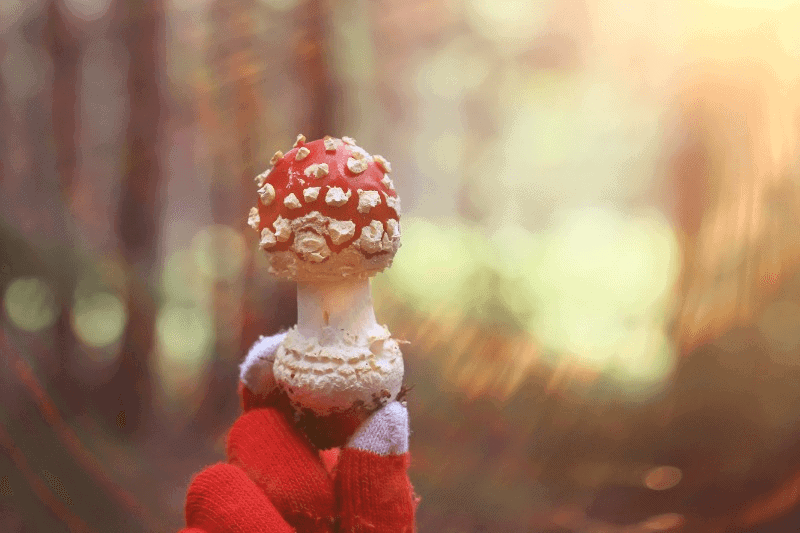
Description
The Amanita muscaria mushroom is easy to spot. Its red cap with white spots is its hallmark. This unique feature sets it apart in the forest floor’s mosaic.
The mushroom grows large, up to 20cm across when fully mature. Its size alone makes it noticeable among other fungi.
Its stem, usually white or slightly yellowish, supports the striking cap. A skirt-like ring encircles the stem, adding to its distinctive appearance. The flesh of this mushroom is pure white but can turn yellow if bruised or damaged.
However, beauty can be deceptive. Despite its appealing look, Amanita muscaria is toxic if eaten without proper preparation.
Classification
Amanita muscaria belongs to a large family of mushrooms known as Amanita. This group includes both edible species and some of the most lethal mushrooms known.
It falls under the Basidiomycota division of fungi due to how it reproduces through spores.
Given its significant size at maturity, it’s classified as a macrofungus. This classification highlights not just its physical stature but also its ecological role.
This mushroom differs markedly from psilocybin mushrooms both chemically and visually.
Distribution
Primarily found in the Northern Hemisphere, Amanita muscaria has a broad distribution range.
- It thrives in coniferous and mixed forests where conditions suit its growth.
- The fungus has also made appearances in parts of the Southern Hemisphere.
Their seasonal emergence typically follows summer rains which provide ideal moist conditions for growth.
Spore dispersal mechanisms allow these mushrooms to spread across vast areas efficiently.
Habitat
The preferred habitats for Amanita muscaria are moist yet well-drained soils within woodlands.
- Pine
- Birch
- Spruce
- Fir
These trees offer optimal living conditions for this species by ensuring sufficient moisture levels while avoiding waterlogged environments.
This fungus can adapt to various elevations making them versatile residents from sea level up into mountainous terrains.
Fascinatingly enough,** Amanita Muscaria often forms fairy rings**, creating enchanting circles on forest floors that fuel myths and legends about their origins.
Additionally,** they engage in symbiotic relationships with certain tree roots**, benefiting both parties involved.
Psychedelic Properties of Amanita Muscaria
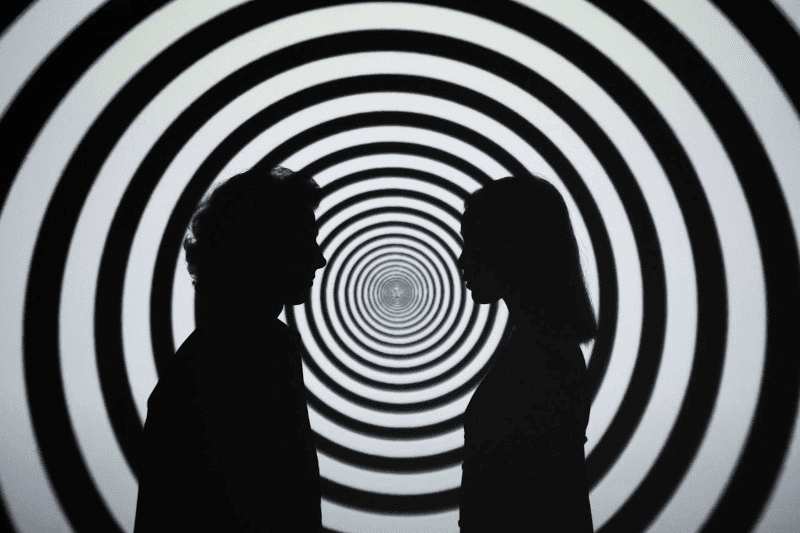
Effects of Amanita Muscaria
Amanita Mushrooms are quickly becoming a popular trend in the United States due to the mushrooms unregulated status and mildly psychedelic effects. Learn all about the effects of amanita muscaria below:
Psychoactive
Amanita muscaria mushrooms contain muscimol, a substance responsible for their psychoactive effects. People who ingest these mushrooms might experience altered perception, euphoria, and hallucinations. Unlike other psychedelics that target serotonin receptors, Amanita muscaria acts on GABA receptors in the brain. This difference explains why its effects can be distinct from those of substances like LSD or psilocybin.
The psychoactivity of Amanita muscaria varies greatly. It depends on both the dosage consumed and individual sensitivity to the compounds within the mushroom. Some might feel strong effects with small amounts, while others need more to notice any changes.
Effects typically begin within an hour after ingestion. They can last anywhere from four to ten hours. The duration and intensity again depend on various factors including how much one has taken and their personal tolerance levels.
Psychedelic
Amanita muscaria is often considered more deliriant than a classic psychedelic mushroom. Its effects are less about vivid hallucinations or profound insights but more about inducing dream-like states. This distinction sets it apart from mushrooms containing psilocybin, which tend to offer clearer visuals and deeper emotional experiences.
Users report that Amanita muscaria leads them into states resembling dreams rather than reality-shifting visions common with “true” psychedelics like LSD or Psilocybe cubensis (a species rich in psilocybin). These differences highlight the unique place Amanita muscaria holds among psychoactive substances.
Active Compounds
Muscimol and ibotenic acid are primary active compounds found in Amanita muscaria mushrooms.
- Muscimol is notably potent—five times more so than ibotenic acid.
- Small amounts of muscazone and muscarine also exist within these fungi, though they play lesser roles in its overall psychoactive profile.
Understanding these compounds helps explain why people have such varied experiences with this mushroom. Potency plays a significant role here; even slight variations in compound concentrations can lead to different perceptual changes.
Pharmacology
The pharmacological action of Amanita muscaria begins when ibotenic acid decarboxylates into muscimol. This process occurs naturally through drying or cooking the mushrooms before consumption. Once converted, muscimol interacts with GABA receptors leading to sedative-hypnotic effects distinct from other psychedelics which primarily affect serotonin receptors.
This mechanism underlines why Amanita’s impact feels different—it doesn’t just alter perception but induces a state akin to hypnotic sedation. Such properties make it stand out among substances classified under hallucinogenic properties due not only to its unique interaction sites (GABA vs glutamate receptors) but also because of its distinctive subjective experience compared against traditional serotonergic psychedelics.
Traditional and Modern Use

Culinary Uses
Amanita muscaria mushrooms have a unique place in culinary history. Some cultures consumed these mushrooms after careful preparation. They boiled them in water several times, discarding the water each time to reduce toxicity. This process was crucial.
Despite this method, amanita muscaria is not widely used in mainstream cuisine today. The risk factors associated with its consumption outweigh its culinary value for most people. Its historical use illustrates an intriguing aspect of human ingenuity in food preparation.
The mushroom’s bold appearance may attract curiosity about its taste and potential as a food source. However, the knowledge required to safely prepare it limits its use to those familiar with traditional practices.
Entheogenic Practices
Amanita muscaria holds significant importance within certain spiritual practices due to its visionary properties. In neo-shamanic circles, it is often seen as a sacrament. Practitioners employ it ceremonially for connecting with the spirits of nature or the inner self.
This use underscores the deep relationship between humans and psychoactive plants throughout history. It highlights how substances like amanita muscaria can play roles beyond mere physical nourishment—serving as bridges to spiritual or psychological realms.
The careful ceremonial use of amanita muscaria emphasizes respect for its power and potential dangers when not used responsibly. These practices offer insights into human spirituality and our connection with nature’s mysteries.
Midwinter Celebrations
The link between amanita muscaria and midwinter celebrations is fascinating yet speculative.
- Some theories suggest an influence on Santa Claus mythology.
- Reindeer are known to consume these mushrooms, leading some researchers to draw connections between their behavior alterations and Christmas traditions.
- Amanita muscaria features prominently in various winter solstice observances around the globe.
These connections point toward humanity’s tendency to find symbolic meaning in natural phenomena—a way of making sense of the world through stories that weave together fact and folklore.
Such traditions underscore the mushroom’s role not just as a plant but as a cultural icon intertwined with seasonal festivities across different societies.
Recreational Use
Despite legal risks, some seek out amanita muscaria for its unique psychoactive experience. For those of you who are familiar with hemp-derived cannabinoids–Max Levenson, a writer at Leafly, describes as the “Delta 8 of Mushrooms”.
- Precise knowledge of preparation techniques is essential for recreational consumption.
- Potential health risks include nausea and confusion which deter recommendation for such uses.
This pursuit highlights both human curiosity towards altered states of consciousness and the importance of respecting natural substances’ power.
Recreational users navigate a fine line between seeking novel experiences and ensuring safety, illustrating broader themes around drug use’s societal perceptions.
Amanita Muscaria Consumption Methods
While this article mainly focuses on consuming amanita muscaria in its raw or dried state, there are many other options when it comes to consuming this fantastic fungi.
Brands like Erth Wellness, Mushroom Lyfe, and others have manufactured a wide range of products that contain either an amanita muscaria extract or isolated compounds of the primary active compounds like Iboetnic Acid and Muscimol. Options may vary depending on where you live, but here in California, you can find a wide range of amanita mushroom products including edibles like gummies and chocolate bars, disposable vape and vape cartridges, tinctures, and capsules.
How to use amanita muscaria?
Usage of this mushroom depends on the consumption method, which will vary. For more information on how to use amanita muscaria, the different consumption methods available, and suggested products, check out our related guide, How to Use Amanita Muscaria: A Complete Guide.
Comparative Analysis
Amanita Mushrooms Vs. Psilocybin Mushrooms
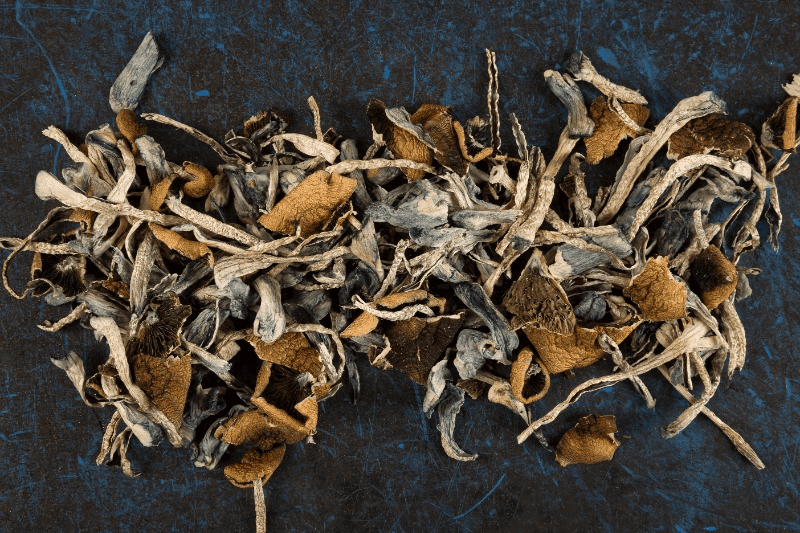
Amanita muscaria and psilocybin mushrooms are both known for their ability to induce a psychoactive, mind-altering state. However, they differ significantly in terms of effects and user experiences. Users often report that Amanita muscaria induces a less visually stimulating experience compared to psilocybin mushrooms. The vivid colors and geometric patterns frequently associated with psilocybin are less common.
The introspective or spiritual aspects also differ greatly between these two types of mushrooms. Many users find psilocybin mushrooms to lead to more profound personal insights or spiritual experiences. In contrast, Amanita muscaria is often considered less introspective. This might be due to the different active compounds present in each mushroom type.
Moreover, the legal status of these mushrooms varies globally, affecting availability and research opportunities. While psilocybin-containing species have seen a recent surge in decriminalization efforts in some parts of the world, Amanita muscaria’s legality remains more varied.
Legal Differences
The legal landscape surrounding Amanita muscaria is complex and varies widely from one country to another.
- In Australia, it is considered a controlled substance.
- Conversely, Mexico does not regulate its possession at all.
This variation reflects broader cultural attitudes towards psychoactive substances and natural hallucinogens specifically.
For instance:
- Some countries view Amanita muscaria through a historical lens, acknowledging its traditional use without strictly regulating it.
- Others prioritize public health concerns stemming from potential misuse, leading to stricter control measures.
These differing approaches can make international travel with such substances risky for uninformed individuals.
Toxicity and Safety
Symptoms of Ingestion
Amanita muscaria, while stunning, poses significant health risks if ingested in its raw state. Symptoms can range from mild to severe. Mild symptoms often include nausea and dizziness. Severe cases escalate to delirium or seizures.
The onset of these symptoms typically occurs within an hour after ingestion. They can last several hours. Without prompt treatment, the situation might worsen quickly.
In some instances, individuals may not realize they’ve consumed parts of the mushroom until symptoms begin. This delay in recognition complicates treatment efforts.
Symptoms can escalate rapidly without proper intervention. In extreme cases, this could lead to potentially fatal outcomes if untreated properly.
Public Health Implications
The presence of Amanita muscaria mushrooms in natural settings requires public vigilance. Healthcare providers should be especially aware in regions where these mushrooms grow wild.
Public education is crucial for reducing accidental ingestions. This is particularly true for children and pets who might find them appealing due to their bright coloration.
Efforts should focus on:
- Identifying Amanita muscaria.
- Preventing accidental ingestion.
Awareness campaigns can significantly reduce the risk of poisoning from these mushrooms.
Treatment for Poisoning
Currently, no specific antidote exists for Amanita muscaria poisoning making supportive care vital for managing symptoms effectively.
Treatment primarily includes hydration and monitoring vital signs until the toxins are metabolized and excreted by the body.
Activated charcoal is sometimes used during the early stages of absorption minimization but its effectiveness varies case by case.
Benefits and Medical Potential

Nutritional Value
Amanita muscaria, commonly known as the fly agaric mushroom, has intrigued people for centuries. Its bright red cap speckled with white dots is iconic. However,This mushroom offers minimal benefits from a nutirtional perspective. It is primarily composed of water and fiber. This composition makes it clear that Amanita muscaria is not a viable food source from a nutrition standpoint.
Historically, its use in culinary practices was more related to ritualistic purposes rather than sustenance. Various cultures have incorporated Amanita muscaria into their traditions and ceremonies, often after processing methods aimed at reducing its toxicity.
The historical fascination with this mushroom underscores an important point: while not nutritious in the conventional sense, Amanita muscaria holds other values that have captivated human interest throughout the ages.
Scientific Studies
In recent years, there has been a limited but growing interest within the scientific community regarding the medicinal potential of Amanita muscaria. Particularly noteworthy are its neuroprotective and anti-inflammatory properties. These findings suggest that beyond its traditional uses and notorious reputation for toxicity, there might be therapeutic benefits lying beneath its surface.
Research on these mushrooms is still in preliminary stages; much remains unknown about their full range of biochemical effects on human health. Scientists are cautiously optimistic but emphasize that further studies are necessary to fully understand how these compounds interact with human biology.
This burgeoning area of research represents an exciting frontier for medical science; exploring how substances once deemed purely toxic could offer new avenues for treatment options.
Therapeutic Value
Despite the lack of rigorous clinical trials to substantiate claims thoroughly, anecdotal evidence suggests potential benefits in treating conditions such as insomnia and anxiety due to sedative properties found within Amanita muscaria components like muscimol.
However, it’s crucial to highlight that much of what we know about the medicinal value of this fungus remains largely speculative at this stage.
- Sedative effects may offer relief for some individuals struggling with sleep disorders or heightened anxiety levels.
- The absence of comprehensive studies means any use should proceed with caution under professional guidance.
The intrigue surrounding Amanita muscaria stems from both its historical significance and emerging possibilities hinted at by early-stage research into its pharmacological profile.
By examining both traditional knowledge and modern scientific investigations into Amanita muscaria, we gain insights into potentially untapped sources of medicine derived from nature itself.
While acknowledging past concerns over toxicity detailed previously highlights why thorough understanding through continued research is essential before any definitive conclusions can be drawn regarding safety or efficacy.
As science progresses towards uncovering more about these mysterious fungi’s capabilities, we remain hopeful yet cautious, recognizing both challenges posed by inherent toxicities alongside promising glimpses into possible therapeutic applications waiting discovery’s horizon.
For additional information about the potential therapeutic benefits of amanita muscaria along with supporting research studies, check out our related guide, Amanita Muscaria Benefits: Insights, Research, and Testimonials.
Side Effects and Risks of Amanita Muscaria
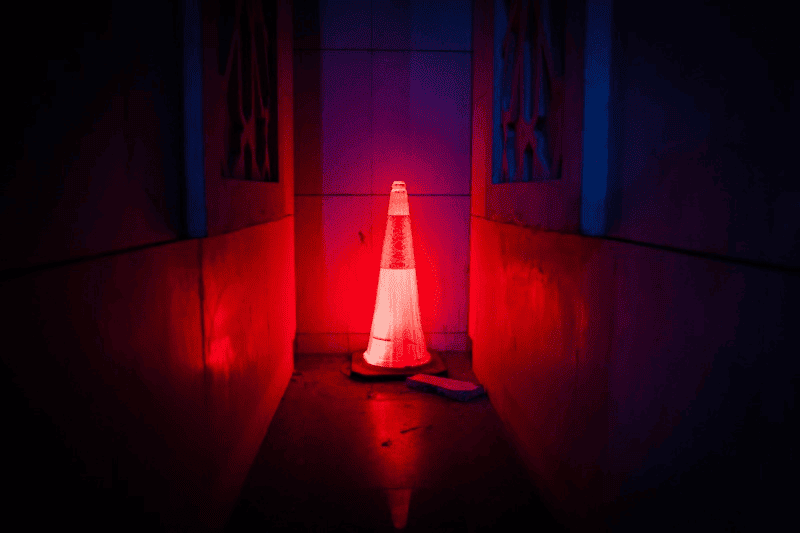
Consumption Risks
Amanita muscaria, while fascinating for its historical uses and striking appearance, carries significant consumption risks. The primary concern stems from the high risk of poisoning due to the variability in potency among individual mushrooms. Even mushrooms growing within the same patch can have drastically different levels of active compounds.
One mushroom may be relatively safe to consume with proper preparation, while another could lead to severe adverse reactions. Symptoms of poisoning can include stomach pain, nausea, vomiting, and drowsiness, highlighting the unpredictable nature of this species.
Improper preparation further increases these risks significantly. Amanita muscaria contains compounds that need specific processing to reduce their toxicity. Uninformed consumption without adequate knowledge or disregard for these processes can be dangerous or even fatal.
The dangers are compounded by a lack of widespread understanding regarding safe consumption practices. Many individuals may experiment with Amanita muscaria based on fragmented information or curiosity about its psychoactive properties without fully appreciating the potential consequences.
Legal Status
The legal status of Amanita muscaria varies dramatically from one jurisdiction to another. In some countries or states, possession, sale, and cultivation might be entirely legal under certain conditions; in others, any association with this mushroom could result in severe legal complications.
It is crucial for anyone interested in exploring Amanita muscaria for any reason—be it research, personal use, or otherwise—to familiarize themselves with local laws thoroughly before seeking out or using this fungus.
- In some regions where it’s considered a controlled substance,
- Possession might lead to fines or imprisonment.
- Sale could result in more severe penalties.
- Cultivation often falls into a gray area but generally aligns with possession laws.
Conversely,
- Areas with laxer regulations might not penalize possession but still regulate sale and distribution closely.
Understanding these nuances is essential not only for avoiding legal troubles but also as part of responsible use and study of psychoactive substances like Amanita muscaria.
Given its complex nature—both legally and biologically—it’s advisable to approach any interaction with Amanita muscaria cautiously:
- Research thoroughly before considering consumption.
- Ensure you’re well-informed about identification methods since misidentification can have dire results.
- Always prioritize safety over curiosity when dealing with potentially harmful substances like this mushroom.
Practical Information
Dosage Tips
Given the natural variability of active compounds in amanita muscaria, and individual sensitivities, precise dosing is challenging. It’s crucial for those considering its consumption to start with a low dose. This cautious approach helps mitigate risks discussed previously.
One should never rush into consuming higher doses. The effects can vary widely among individuals. Some may experience intense reactions from small amounts.
It’s advisable to wait and observe the body’s response over time. This waiting period allows for safer personal assessment of tolerance levels.
Preparation Tips
Proper preparation of amanita muscaria is vital to reduce toxicity levels to a safer threshold for consumption. The process involves boiling the mushrooms and discarding the water at least twice.
Never consume these mushrooms raw or dried without thorough processing first. Skipping this step can lead to severe health risks.
Here are key steps in preparing amanita muscaria:
- Slice the mushrooms thinly.
- Boil them in plenty of water for about 15 minutes.
- Discard the water and repeat the process once more.
This method helps lower toxin content while preserving the mushrooms psychedelic properties.
Varieties
Amanita muscaria has several subspecies that differ in cap color, size, and geographic distribution. These variations can also mean differing potencies which necessitate different handling and cautionary measures when considering their use either recreationally or as entheogens.
The most commonly recognized variety has a bright red cap with white spots but other varieties include:
- Amanita muscaria variegata (yellow caps)
- Amanita muscaria regalis (brown caps)
Each variety requires careful attention to preparation methods outlined above due to varying potency levels.
Duration and Onset of Effects
Onset of Effects: How Long Does it Take to Kick In?
The effects of Amanita mushrooms typically begin to manifest around 30 minutes after ingestion, although for some individuals, it might take up to an hour and a half to feel the full impact. The amount consumed can also alter the timing of the onset.
Duration of Effects: How Long Does It Last?
These effects generally last between 4 to 6 hours. It’s important to note that the experience with Amanita muscaria varies from person to person, leading to a wide range of potential timelines and durations for its effects.
Mythology and Symbolism
Influence on Celebrations
Amanita muscaria, with its distinctive red cap and white spots, has woven itself into the fabric of various cultural festivities. This mushroom symbolizes life, death, and the rebirth cycle in many traditions. It marks a significant presence in celebrations that honor these phases of existence.
In some cultures, Amanita muscaria’s appearance during certain times of the year aligns with traditional festivals. These events often celebrate seasonal changes which mirror life’s cycles. The mushroom’s growth after rain can symbolize rebirth or renewal following periods of decay or dormancy.
Modern holiday celebrations also feel the influence of this iconic fungus, albeit more subtly. Folklore and popular culture occasionally nod to Amanita muscaria through characters or themes that embody transformation or journeying between worlds—concepts central to many stories shared during festive seasons.
Symbolism in Culture
The symbolism surrounding Amanita muscaria extends beyond mere representations of nature’s cycles; it delves into human consciousness and spirituality.
For followers of neo-shamanism and other esoteric movements, this mushroom stands as a beacon for enlightenment and spiritual practices. Its use is often shrouded in rituals meant to induce visions or journeys beyond physical realms—a testament to its power but also a reminder of its danger if not approached with respect.
The dual nature of Amanita muscaria—its beauty juxtaposed with potential harm—highlights an essential lesson about interacting with the natural world: admiration must come hand-in-hand with caution. This balance reflects broader dialogues about how humans engage with psychoactive substances within their environments.
Despite its risks, Amanita muscaria continues to captivate those seeking mystical experiences or alternative treatments for ailments conventional medicine cannot address. Its allure lies not just in its effects but also in the rich tapestry of cultural associations it carries—from ancient religious rites to modern-day recreational experimentation.
Legal and ethical considerations around Amanita muscaria underscore an ongoing debate about personal freedom versus public safety—a complex issue given this mushroom’s potent background. While some regions have strict regulations regarding its possession and use, others adopt more lenient stances, reflecting varied societal attitudes toward psychoactives generally.
As scientific research evolves, new insights may emerge about both medicinal and recreational potentials offered by Amanita muscaria. Studies exploring its compounds could unlock novel applications for health while deepening our understanding of traditional practices involving this enigmatic organism.
Ultimately, whether one engages with Amanita muscaria from a cultural perspective—as partaking in age-old rituals—or approaches it as a possible source for healing or recreation, respect and caution are paramount principles guiding any exploration into what this fascinating fungus has to offer humanity.
Ready for a Trip?
Amanita muscaria stands as a significant species, weaving through history with its distinctive appearance and unique effects. It has traversed the realms of mythology, medicine, and modern psychoactive exploration, presenting a multifaceted profile that intrigues scholars and enthusiasts alike. Its identification, taxonomy, and psychoactive attributes have been thoroughly examined, alongside its traditional uses and comparative significance among other species. Moreover, discussions on toxicity, safety measures, benefits, medical potential, side effects, risks, practical information, and symbolic meanings have enriched the understanding of this iconic mushroom. The collective insights from these sections underscore the importance of informed interaction with Amanita muscaria, whether for academic, medicinal, or personal exploration purposes.
The exploration of Amanita muscaria invites further research and discussion. Readers are encouraged to delve deeper into the topics presented, fostering a greater appreciation for the complexities of this fascinating species. Its historical roots and contemporary relevance offer a rich field for study and reflection.
We appreciate you taking the time to read our guide and hope that it helped provide value for you. If you found this guide helpful, please help spread the word about Amanita Explorer and join our newsletter to get our latest articles, buyer’s guides, and news sent straight to your inbox.
Frequently Asked Questions
What is Amanita muscaria?
Amanita muscaria, commonly known as the fly agaric, is a mushroom species renowned for its distinctive red cap with white spots. It’s notable both for its psychedelic properties and its role in various cultural traditions.
How can you identify Amanita muscaria?
Amanita muscaria can be identified by its bright red or orange cap covered with white warts, white gills, and a bulbous base. Identification should always be done cautiously to avoid confusion with toxic species.
Are there any traditional uses of Amanita muscaria?
Traditionally, Amanita muscaria has been used in shamanic rituals in Siberian and Northern European cultures for its psychoactive effects. It was also employed as an insecticide when sprinkled into milk.
What makes amanita mushrooms psychoactive?
The psychoactive effects of Amanita muscaria stem from compounds like ibotenic acid and muscimol which act on the brain’s neurotransmitters causing altered perception, mood changes, and sometimes euphoria or hallucinations.
Is consuming Raw Amanita muscaria safe?
Consuming Amanita muscaria in its raw state poses significant risks due to its toxicity. Symptoms of poisoning include nausea, dizziness, confusion, and muscle spasms. Extreme caution is advised if consumption is considered despite these dangers.
Are amanita-based products like Amanita Gummies safe?
While there have been no reported cases of lethal or life-threatening circumstances from using amanita mushroom products like edibles, vapes, or chocolates, it’s highly recommended to proceed with caution as effects can vary widely from person to person.
What medical potential does Amanita Muscaria hold?
Research suggests that compounds found in Amanita Muscaria may have medicinal potential such as neuroprotective properties or as antiviral agents. However, more scientific investigation is needed to fully understand these benefits within a medical context safely.
Can you describe the mythology associated with Amanitia Muscária?
Amania Muscária features prominently in folklore across several cultures; it’s often linked to immortality myths and spiritual journeys due to its hallucinogenic properties. Its iconic appearance also makes it a frequent symbol in popular culture representing magical or enchanted forests.
Is it legal to buy Amanita Muscaria products in the United States?
Amanita muscaria mushrooms and their extracts are legal in almost all states except Louisiana, where they’re banned. Unlike psilocybin, which is a controlled substance, the active components in amanita mushrooms aren’t federally regulated, making them legal in most places.
Where can you buy amanita muscaria products?
Due to its fast-growing popularity, amanita-based products can be found at a wide variety of retailers, both online and locally (unless you’re in Louisiana). A number of brands including Galaxy Treats, Exhale Wellness, and Elyxr offer some great products at affordable prices and ship through most of the United States.
